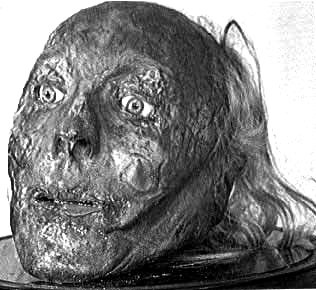Lintoniana V
“Never did corpse of hero on the battle-field, (…) exite such emotions as the stern simplicity of that hour, in which the principle of utility triumphed over the imagination and the heart.“ (The Monthly Repository, 1832)
What did Linton actually mean when, at the end of his conversation piece Cetewayo and Dean Stanley, he had the defeated Zulu chief say: “But do not put me in your Abbey, Mr. Dean, along with this boy (…) !”? Why did Cetewayo speak about himself and the Prince Imperial here, where the real issue was their monuments? Did the author merely seek to express a reducing, linguistic awkwardness, or rather a naive animism that mistakes the sculptural simulacrum for the original, similarity for identity? And the Abbey? Was it the main objective of Linton’s Cetewayo to avoid Westminster Abbey as a specific site of incoherence, in which “due” and “undue honours” are mixed – he, as a serious defender of his nation, alongside a reckless adventurer who kills “for his private amusement” – or did he see it as the “chief temple” of a belligerent imperial religion that was responsible for the subjugation of his people?
An explanation is given in an essay by Walter Savage Landor, from which Linton had already cited in the introductory motto of his piece.1 In Sir Robert Peel and Monuments to Public Men, Landor reflected on adequate possibilities to “commemorate the great worthies of our country.” He called for making a fundamental difference between famous persons from public-political and cultural life, and allocating public space accordingly. Interior spaces, “our vestibules and our libraries are best adorned by poets, philosophers, and philanthropists”; yet what must be judged higher than the cultural elite is the political caste, predominantly the military, the “defenders of their country”, and then the legislative, the “maintainers of the law”. According to Landor, the higher status of these persons is represented in public outdoor space, “in the streets, in squares”, the classical location of the res publica. For that is where “street-walking and publick-meeting men” encounter the proprietors of the names they constantly talk about, but whom they are hardly familiar with, although they are tied to them through a feeling called loyalty, “a feeling intemperate and intolerant, smelling of dinner and wine and toasts, which swells their stomachs and their voices at the sound of certain names reverberated by the newspaper press.”
Landor’s conception of the monument was less an idealistic cult of paying homage than a utilitarian teaching lesson that transformed urban space into a three-dimensional history atlas. Accordingly, the sculptures were to be best set up in ranges. Excluded from this representation, however, were theologians, because their images would only excite dogmatic discord. Equally, placing worldly monuments in a sacred realm would also amount to disfigurement and desecration. By rejecting Westminster Abbey as a site of secular commemoration, Linton’s King of the Zulus agrees with Landor’s conception.
However, Cetewayo also follows a totally different line of argument that calls into question the use of Anglican service. He doesn’t comprehend the meaning of a specialised state priesthood that holds services only periodically at certain hours. He counters these regularly arranged services with a “right” service which his men rendered to the “pretty boy”, the Prince Imperial. “He was rightly served by my men” could be unsuspiciously interpreted as: It served him right the way Cetewayo’s men treated him. It was indeed known that the way in which the Zulu warriors dealt with Louis Napoleon also possessed a ritual aspect. As the New York Times reported on July 3, 1879, with reference to the English daily press, the Zulu warriors had disembowelled all of the dead on the battlefield “through a superstitious creed of battle.” The corpse of the Prince Imperial had not been spared either and had been “snatched from the sacrilegeous and mutilating hands of the savages who had murdered him”, to the great grief of his mother. The information that the corpse had also been partially scalped most likely owed to the specific imagination of the American press to further stir up feelings. This short-circuiting of the British Zulu war and the genocide of the indigenous population of North America certainly had the opposite effect on Linton, possibly also inspiring him to write the conversation piece in distant Connecticut.
Most products of his American private press were addressed with specific allusions to a relatively small circle; the Cetewayo and Dean Stanley piece, of course, particularly to his acquaintances in London. There, the allusion to the “rightly” disembowelled body of the prince, especially because it was connected to the cult of monuments, had to inevitably trigger associations to a ceremonial, public dissection at the outcome of which stood the origin of a memorial sculpture. Although this ceremony had taken place almost thirty years beforehand, the memory of it must have been extremely present among Linton’s circle of acquaintances, especially at the time the piece was written, for it had been no less than an informal foundation act of the secular movement that made an appearance at the time with audience-grabbing actions and became the topic of fierce controversies.
The corpse which had been subjected to this procedure of dissecting disembowelment belonged to Jeremy Bentham, the most important philosophical proponent of early British radicalism and the most fundamental critic of colonialism and Anglicism in the 19th century.2 For Goethe, who was of the same age, the thoughts of the founder of Utilitarism marked the “peak of madness”3, and even a commentator such as William Hazlitt, who was politically well-disposed towards Bentham, criticised him for his “barbarous philosophical jargon” and wondered that he had not yet been “prosecuted for the boldness and severity of some of his invectives.”4

W. J. Linton: Portrait of Jeremy Bentham. The Reasoner, 26 April 1848
Benthamism is often understood as an expression of a narrow-minded, puritan trader’s ethics that philosophically indulges in a pure cost-benefit calculation. But this would mean to disregard the explosiveness that Bentham’s philosophy unfolded, particularly in England. It mainly consisted in the fact that he had shaken and challenged puritan ethics through the pronounced hedonistic approach of his principle of “greatest happiness”. But also the accusation of propagating an unrestricted “swinish” egotism did not gain traction, because, in his view, from the perspective of society as a whole, the principle of maximising happiness necessarily resulted in the coinciding of self-interest and duty as service to the community. As opposed to latter-day interpretations, early, inconsistent Benthamism was both individualistic and communitarian. It can be regarded as the open attempt to create a vital societal set of rules based on neither the authority of conventions nor transcendent entities.
Young Linton must have encountered Bentham’s stuffed corpse quite often at the dinners in the home of his fatherly friend and family doctor, Thomas Southwood Smith, where the deceased sat dressed in his everyday clothes in a glass case, on view for anyone “who takes an interest in the writings and character of Jeremy Bentham.”5 Southwood Smith had been one of the closest friends of the barbarous philosopher. In 1824 the committed physician, in his essay “The Use of the Dead to the Living”, had called for allowing anatomical gifts, and Bentham, radically demonstrating his utilitarian principles, had not only made his own body available, but also written in his will that it be preserved “in the manner of the New Zealanders for the purpose of commemorating the Founder.” As contemporary witnesses reported, the public dissection along with the funeral address had been performed by Southwood Smith himself, “with a face as white as that of the dead philosopher before him”, in the charged atmosphere of a sudden thunderstorm.6
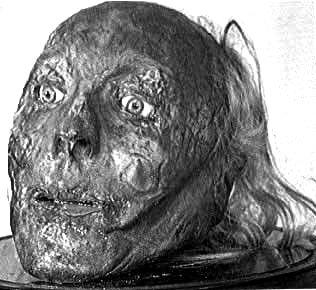
The result of the mummification of Bentham’s head did not satisfy Southwood Smith.
Today, the name of Southwood Smith is undeservedly mentioned almost only in connection with performing the bizarre will of his philosophical teacher. The physician was actually an astonishingly complex personality who left his mark on the social history of the early 19th century through his pioneering achievements in regard to sanitary reformation. His moral-theological writings also had an influence on the poetry of High Romanticism. He had been encouraged to take on his post as a Unitarian preacher, which he held for many years, by William Blake. The unity of mysticism, scientific facticity and social commitment, which he embodied, played a significant role in the paradigm change from poetry to prose as an Early Victorian key medium, ushered in at the beginning of the 1830s.
Only a few years after Bentham’s death and his conversion into a memorial sculpture, Southwood Smith established himself as a central figure in a circle of young poets, philosophers and artists that regularly met at the house of his close friend, the Unitarian dissenter William Johnson Fox in Craven Hill Gardens in London and included Robert Browning, Eliza Flowers, Margaret Gillies, Richard Hengist Horne, Douglas Jerrold, Harriet Martineau, John Stuart Mill, Harriet Taylor, Thomas Wade, Egerton Webbe, as well as the budding xylographer and poet William James Linton.7 In her fundamental work on Victorian poetry, the literary historian Isobel Armstrong characterises this circle around Fox and Southwood Smith, “experimenting with the new in political, theological and aesthetic matters”, as the earliest recognisable avant-garde group in Great Britain alongside the Cambridge Apostles surrounding Tennyson.8 The central mouthpiece of this group, which was described by James Martineau as a “free-thinking and free-living clique”, was the literary magazine The Monthly Repository, edited by Fox, that also played a pivotal role in establishing early workers’ literature as a literary genre to be reckoned with. With his periodical, according to Armstrong, the editor forged a “Utilitarian, Benthamite aesthetic. (…) His reading of Benthamism meant in the first place, the dissemination of pleasure in its widest sense, the democratisation of literature and the exploration of the links between literature and politics.” Beside Bentham’s radical scepticism, which was able to cast a foreign, “barbarous” view on social contexts, it was mainly Percy Bysshe Shelley’s blasphemous poetry that had a shaping influence on the Craven Hill circle. The explosive mixture of atheist and class struggle-oriented thought paved the way for the secularist movement that was institutionalised in the mid-1860s.9
Bentham’s followers avoided going into detail and discussing his mummification in public. In the Monthly Repository, longer excerpts from Southwood Smith’s funeral oration were printed, and the act of dissection itself was also mentioned, but not a word was said about his second testation. After all, one did not want to fall into disrepute as a neo-heathen sect that in blasphemous reversal of Christian myths gathered around the stuffed corpse of its master, who had even been preserved in the manner of Stone Age savages. However, it can be assumed that most artists of the Craven Hill circle were familiar with Southwood Smith and Bentham’s master student John Stuart Mill and all the details of this spectacular matter, certainly including the detailed proposals to revolutionise the culture of commemoration that Bentham had presented in this context. Although he wrote them down only shortly before his death in an unpublished manuscript,10 he must have dealt with this set of ideas for quite some time – for he had carried the glass eyes, which were meant to one day lend his mummified skull a lively expression, in his waistcoat pocket for twenty years.
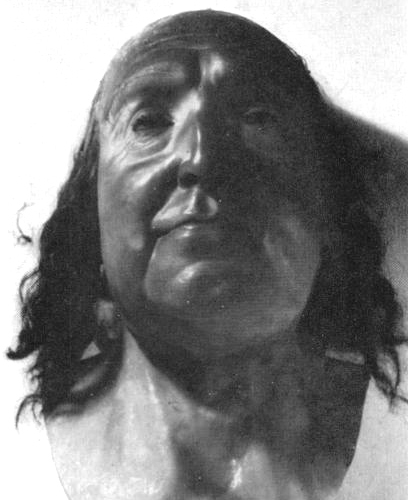
Jacques Talrich: Wax head of Bentham. The artificial substitute had been commissioned by Southwood Smith. (Source: C. F. A. Marmoy ,The ‘Auto-Icon’ Of Jeremy Bentham At University College, London)
In Bentham’s view, the human corpse benefited society in two ways, possessing an “anatomical, or dissectional” as well as a “conservative, or statuary” value. He attributes the term auto-icon to the latter. These body sculptures would “supersede the necessity of sculpture”, for it is after all evident that “identity [is] preferable to similitude”. In Bentham’s vision of the future, which suffices entirely without the mimetic services of art, the auto-icons populate not only public buildings and private, ancestral portrait galleries, but also – after having been made weatherproof through the impregnation with rubber – outdoor spaces, parks and alleys. What he does not elaborate is the consequence of his playful and capricious proposals, which, however, is obvious and lies in radically levelling and democratising the cult of commemoration shaped by feudal patterns, i.e., the cultural segment that, in Bentham’s eyes, formed the ideological backdrop of a reduced and irrational understanding of the nation.
Linton’s Cetewayo partially appears as a revenant of Bentham. Equipped with disarming practical intelligence, something Bentham had termed “savage ingenuity”, he called into question the foundations of the Anglican state church,11 to finally abruptly declare that he would withdraw from not only the ideological co-optation by a hypocritical, two-faced imperial religion but also the chaotic ambivalence of historical ancestor worship. But the categorical consequence also quite clearly expresses the aversion of the reproduction graphic artist Linton towards the mechanised logic of Benthamism, which no longer left any room for mimetic difference. In the end, it is the dissolution of this difference in an automated icon that Cetewayo shies away from here, at the same time as his author was involved in a fundamental dispute with the photographic hyperrealism of young American xylography. Linton’s Cetewayo is Bentham, as far as the colonial-political perspective is concerned. In regard to the ethical and aesthetic perspective, he is anti-Bentham.
There is hardly a comparable document that expresses the ambivalence of British radicalism regarding its utilitarian foundation as suggestively and incisively as this inconspicuous conversation piece. In his early publications, Linton had still granted a lot of room to Benthamism.12 From the very start, the austere doctrine of maximising use, even if it was hedonistically founded, had hardly been in line with his idealistic altruism. In Fox, he had meet a figure whom he later characterised as “the virtual founder of that new school of English radicalism”, a way of thinking “which looked beyond the established traditions of French revolution, and more poetical, escaped the narrowness of Utilitarism.”13 From the mid-1840 onward, Linton, like many other fellow travellers, replaced Fox’s spiritual Benthamism with a theologically underpinned nationalism in the style of Mazzini, which gave expression to the democratic liberation movements in Europe. It was evident, however, that Mazzini’s vision of a republican Europe and his foundation of a People´s International League was firmly rooted in Bentham’s work on intergovernmental legislation, a state of affairs which he described using the neologism internationality. And it is an open question whether Linton’s anthropomorphous vision of a universal republic, which he had explicated in his central political treatise, The Religion of Organization, adhered to an afterimage of the cadaver of the father of supranationality. For hadn’t Bentham organically manifested his idea of communitarian responsibility with the act of his dissection and, with his mummification, also given an impressive example suitable for lending his highly abstract atomistic theories a corporeal presence?
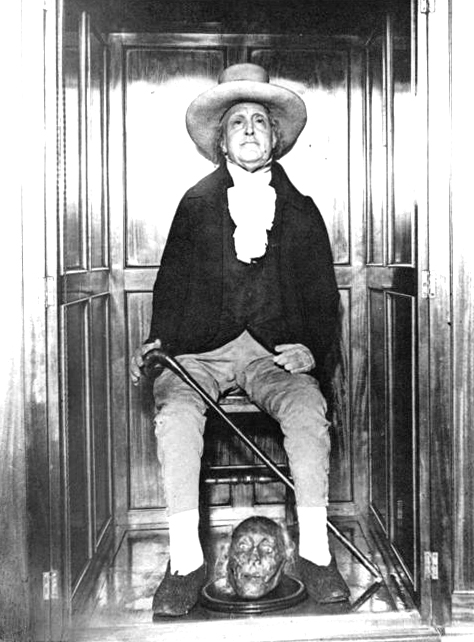
Bentham´s Auto-Icon in the original case with the wax head above and the mummified one below as it had been arranged by Southwood Smith (Source: C. F. A. Marmoy ,The ‘Auto-Icon’ of Jeremy Bentham at University College, London)
The internal connection between Bentham’s auto-iconism and Walter Savage Landor’s post-mortem conversation pieces, in emulation of which Linton’s Cetewayo and Dean Stanley conversation had been written, is striking. Through his younger brother, the inventive military engineer Samuel Bentham, who was a friend of Landor, the philosopher must have been familiar with the genre of imaginary conversations. In their medico-historical essay, Jeremy Bentham’s self image: an exemplary bequest for dissection from 1987, Ruth Richardson and Brian Hurwitz presume that Bentham’s idea of staging conversation pieces with mechanically driven auto-icons of deceased savants goes back to Landor’s successful literary model.14 The Voices of the Dead15 in these mummy plays were to be spoken by actors. What Bentham could not have foreseen is that his vision of a theatre of the dead could only be realised in the two-dimensional format of photo-iconic reproduction, the magic medium of film.
In 1880, when Linton had published the Cetewayo and Dean Stanley conversation, only very few befriended members of the Craven Hill circle were still alive, to be precise, only two: Richard Hengist Horne, the multifaceted poet and adventurer who in 1844 had published a literary portrait of Southwood Smith, and the painter of miniatures, Margaret Gillies, who, after Southwood Smith had moved, in the winter of 1849 temporarily accommodated Bentham’s stuffed body before it was then once and for all included in the collection of the University College London. During his time as an emigrant in the United States, however, Linton had managed to establish an extended circle of acquaintances in London, whom he could address with this essay on current affairs. Among them were young Shellyites such as Henry Buxton Forman, as well as a number of proponents of the Arts & Craft movement that had just begun establishing itself. Most of them were members or sympathizers of the secular movement that had formed upon the initiative of Linton’s earlier political companion George Holyoake in the mid-1850s. Although Linton had meanwhile irreconcilably fallen out with Holyoake, accusing his campaign of a fundamental lack of imaginativeness, he unreservedly admired the chairman of the National Secular Society, the social reformer Charles Bradlaugh, for his courage to stand up for his beliefs and his feel for literature. Bradlaugh had allied himself to the Scottish poet James BV Thomson, who knew how to dress “unimaginative” atheism in powerful poetic images.
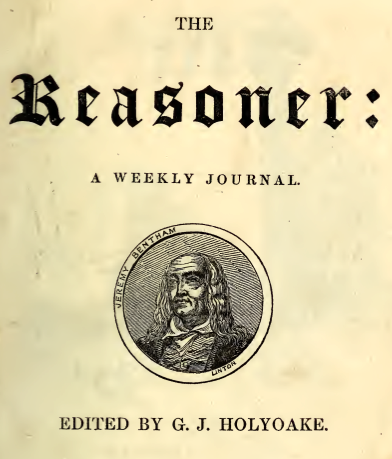
Coverpage of George Holyoake´s wide spread journal “The Reasoner”, where he evolved his system of secularism. Holyoake reused Linton´s depiction of Bentham as a title vignette in a series of
further publications on secularism and the cooperative movement.
When Linton wrote his criticism of the confused representational concept of Westmister Abbey, which Cetewayo had called the “chief temple” of the English state church, the first temple of atheism since the times of the French Revolution was just being built in Leicester, attracting great public attention. It is highly probable that Linton was perhaps not directly involved in this project of a “Temple of Free Thought”, but at least informed of its conception. After all, the printed version of Thomson’s inaugural poem, Address on the Opening of the New Hall of the Leicester Secular Society March, 6th 1881, was illustrated with relief etchings that Linton had made eighteen years earlier for Gilchrist’s Life of William Blake.
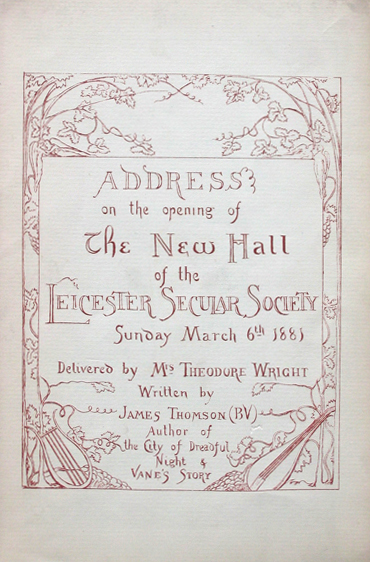
Coverpage of James BV Thomson´s “Address on the Opening of the New Hall of the Leicester Secular Society March, 6th 1881” with kerographies by Linton after Blake (MePri-Collection)
In regard to the didactic coherence of their iconographic programme, the builders of the New Hall were to a large extent in line with Walter Savage Landor’s demand for a range of memorial sculptures in logical sequences. The five terracotta busts in the entrance facade – Socrates, Jesus, Thomas Paine, Voltaire and Robert Owen – represent almost chronologically an informative genealogy of godlessness. The fact that historical Jesus had been included in this secular canon was to be understood as a targeted provocation of Christian orthodoxy following a long tradition of dissenters. It was Linton’s second wife, the writer Eliza Lynn, who in her Victorian bestseller The true History of Joshua Davidson – Christian and Communist from 1871 had in a spectacular manner renewed the antinomian myth of historical Jesus as a social-revolutionary violator of laws and transferred it to the gloomy present of London’s East End. The fact that Jeremy Bentham is missing in this secular memorial sequence must be seen as proof of the diminished reputation of Utilitarism in the radical milieu. Through an increased individualistic interpretation, it had meanwhile been reduced to a pure doctrine of economic liberalism, a development that the ideological split of radicalism had reflected. However, with the bust of Robert Owen, the founder of the early socialist cooperative movement, a philanthropic version of early Benthamism was represented. The barbarous philosopher himself had been financially involved in Owen’s projects.

Socrates ,Jesus , Thomas Paine, Voltaire, Robert Owen: The five busts by Ambrose Louis on the front of the Leicester Secular Hall (Source: Website of the Leicester Secular Society https://www.leicestersecularsociety.org.uk/busts.htm# )
A consistent alternative to the temples of state Christianity was therefore under construction here that celebrated communitarianism and, as a consequence, sought to no longer sacredly legitimise in any way imperialism under its roof. Hence, the topicality of Linton’s colonial-critical conversation piece must also be understood against the concrete background of an ecclesiastic staging and institutionalisation of secularism. Yet it appears doubtful whether Cetewayo’s criticism of Anglicanism can be understood as an unreserved address of sympathy to the secularists. His rejection of the Abbey as a locality of his commemoration, as a place of identification, can also be read as the renunciation of an overall cultural situation consisting in a civilizational break between personal and national salvation, between Jesus and Joshua. If one reads the piece in the context of Linton’s political writings, the place of Cetewayo’s representation can be neither the English temple nor the English park, but a community that grasps political responsibility as a spiritual service, as the religion of organisation, or as a transcended Benhamite corpus.

A spiritual epitomization of the Universal Republic. Headpiece of Linton´s “The Religion of Organization. An Essay read to Friends in Boston,1869.” New Haven 1892 (MePri-Collection)
Alexander Roob, December 2010
(Translation: Karl Hoffmann)
Notes
1 Included in Landor’s late anthology The Last Fruit off an old Tree (1853)
2 Bentham presented his anti-colonial arguments most decisively in the treatise Emancipate your Colonies!, published in London in 1830.
3 Johann Peter Eckermann: Gespräche mit Goethe, 1836
4 William Hazlitt: The Spirit of the Age or Contemporary Portraits, 1825
5 Richard Hengist Horne: A New Spirit of the Age. Vol. I, 1844
6 The Monthly Repository No. 67, 1832 / Richard Hengist Horne: A New Spirit of the Age.1844
7 On W.J. Fox and the Craven Hill circle, cf.: Richard Garnett, The Life of W.J. Fox, Public Teacher & Reformer 1786-1864. London 1910 / Ann Blainey, The Farthing Poet. A Biography of Richard Hengist Horne, 1802 – 1884. London 1968 / Francis Barrymore Smith, Radical artisan, William James Linton, 1812-97. Manchester 1973
8 Isobel Armstrong: Victorian Poetry: Poetry, Poets and Politics. London 1993
9 It was W.J. Fox who defended the founder of the secularist movement George Holyoake in 1842 against the charge of blasphemy.
10 Jeremy Bentham: Auto-icon; or, farther Uses of the Dead to the Living. A Fragment. Unpublished. Only as late as in 1842 was the pamphlet printed and disseminated in a private edition of twenty copies. In 2002 a facsimile edition, edited by James Crimmins, was published under the title Jeremy Bentham’s Auto-Icon and Related Writings.
11 In 1824 the Unitarian Bentham called into question the doctrines of the Anglican Church in his publication The Church of England Catechism Examined.
12 Linton’s first magazine, The National. A Library for the People (1839), contains many excerpts from the writings of Bentham, Stuart Mill and Southwood Smith.
13 in: W.J. Linton, James Watson. A Memoir of the Days of the Fight for a Free Press in England and the Agitation for the People’s Charter. Manchester 1880
14 in: British Medical Journal. Vol. 295, 18 July, 1987
15 The Voices of the Dead is also the title of Linton’s first conversation piece.
